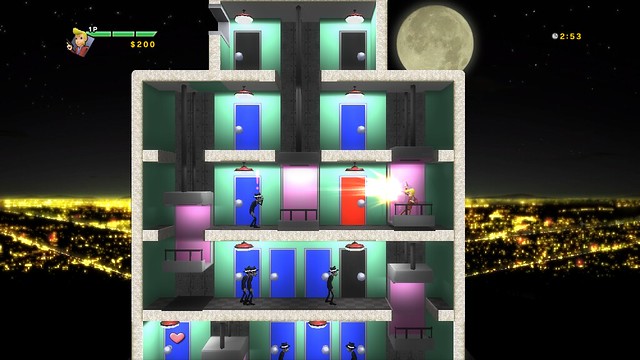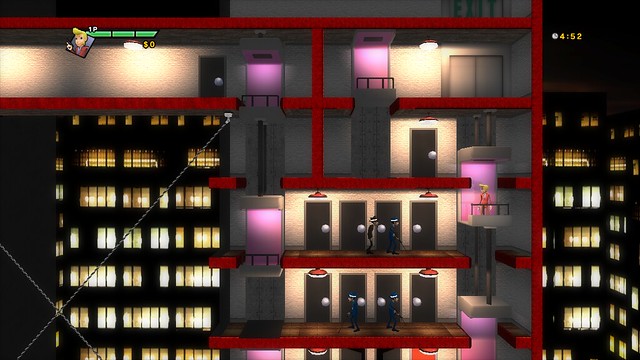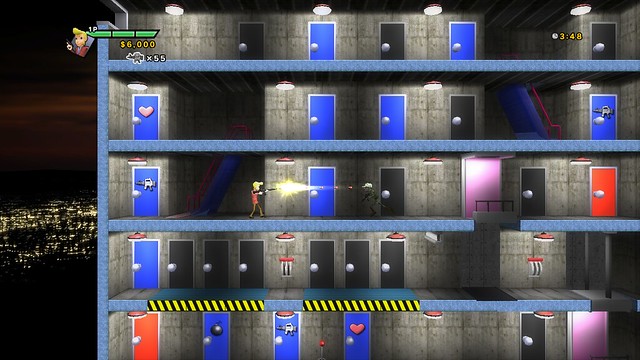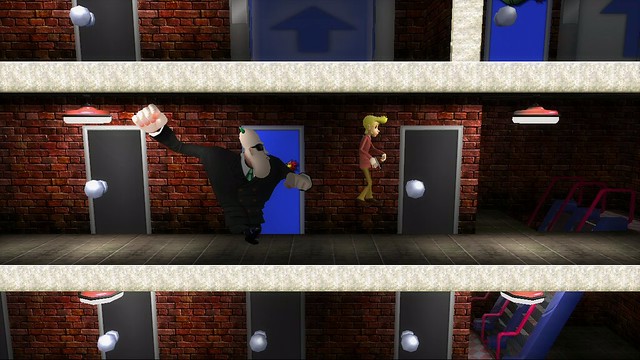Back in the 80s, it wasn’t uncommon for restaurants to have a lone arcade cabinet sitting by the entrance. I’ve got fond, but hazy memories of a suburban Philadelphia diner where I discovered an innovative title called Elevator Action. I also recall a bacon cheeseburger…
In the 80s, most games confined you to a simple side-scrolling plane — it was akin to being on rails. Elavator Action enabled you to traverse a building vertically. It was a revelation. It was true freedom. It was, well, a different time.
So when I learned that Elevator Action Deluxe was on its way exclusively to the PlayStation Network, my nostalgia was inflamed. With the game available tomorrow, Square Enix offered me the chance to ask a few questions of Producer Yosuke Tsuda.

PlayStation.Blog: Would you categorize Elevator Action for PSN as a straight remake or more of a reinterpretation?
Yosuke Tsuda, Producer, Elevator Action Deluxe: We began the development process based on three concepts:
- Have visuals that allow people to instantly recognize this as an Elevator Action game
- Retain and strengthen the original features
- Achieve a level design that invites different play styles
So when you ask me whether it’s a straight remake or more of a reinterpretation, I would have to say it’s a straight remake. However, by respecting the original Elevator Action and adding features from current game trends, the content became fresh, even to me and the rest of the development team.
PSB: What classic elements did you consider to be essential to keep in the new version?
Tsuda: The first concept was to have visuals that allow people to instantly recognize this as an Elevator Action game. Many were against this, but the early stages are similar to the original game, with simple backgrounds.
The second concept was to retain and strengthen the original features. Spies, black clothing, elevators, lamps, blackouts, red doors, escalators, and so on. We enhanced the system and visuals while keeping the identity of the original game.

PSB: How does this Elevator Action compare to Elevator Action Returns, which appeared on Taito Legends 2 for PS2?
Tsuda: Elevator Action Returns is a title from when I was working at Taito and leading the game direction for the first time. In Deluxe and Returns, the remake approach is completely different. In Returns, you progress through different areas using elevators, but the controls and visuals don’t really follow the fundamentals of the original game. By contrast, in Deluxe, we’ve made the controls similar to the original and kept the basic features intact while decorating them and including new icons.
By using zombie movies as a comparison, Elevator Action is George A. Romero’s original “Night of the Living Dead,” Elevator Action Returns is like Zack Snyder’s “Dawn of the Dead,” and Elevator Action Deluxe is like Tom Savini’s “Night of the Living Dead.” (Note that I’m not trying to draw direct comparisons to these movies, but just offer a simple analogy!) Again, the level design in the original game and Returns was tailored for arcades (you can achieve an additional life within three to five minutes!), whereas in Deluxe, the levels are designed for consoles. This is one important element that is vastly different.
PSB: What steps have you taken to modernize the game? What’s new?
Yosuke Tsuda: Shaders, animation, the freedom to choose different play styles, multiplayer, background music…we’ve made the gameplay simple but have made the environments as rich as possible. Especially the point about having the freedom to choose different play styles directly correlates to the concept I mentioned, “[achieving] a level design that invites different play styles.”
For example, in this game we are now able to go inside the blue door whereas in the previous game you weren’t able to. And if you really want to, you can use these new areas to hide as much as you want, until time runs out of course. The 43-year-old project manager who loves the original game was upset, saying that, with the exception of head-to-head match play, there is “no tension,” but I don’t believe that this decision was a mistake.
With this kind of system that allows a high level of freedom and choice, players are able to decide which path to take, either “bulldozing through” or “sneaking through.” We were able to create a game in which players can choose their own play style, making certain that stages were designed so that both play styles would be viable options for clearing the game.
One caveat is that you will need to be tactful and choose between play styles wisely in order to achieve the “gold medals.”

PSB: The original arcade game was single player only. Talk about the multiplayer – what does it feel like stylistically?
Yosuke Tsuda: In regards to the multiplayer…yes, in the beginning we started production with online multiplayer in mind.
However, considering the amount of moving parts in the levels, we would have had to make too many sacrifices to the responsiveness of the controls. Additionally, since players can see the entire level, because of the 2D perspective, we would not have been able to compensate for the input lag without players seeing the game re-sync. I contemplated on this matter deeply, but we ultimately decided to “provide a great experience through a single-player mode,” which is why this version only contains an offline multiplayer mode.
By focusing on the controls, the content of the offline multiplayer mode is quite speedy and thrilling. In story mode, the multiplayer mode will make stage clearing more enjoyable, but, because there is friendly fire, it is imperative to choose roles and talk to each other.
In battle mode, there is a “one door” battle where players must scramble for a single document, an “eight door” battle in which players scramble for documents that keep appearing, and a “Deathmatch” mode which is self-explanatory. These modes are all quite thrilling and built on an exquisite balance of skill and chance. At one time, the battle mode was quite popular with the QA team who would play during breaks.

PSB: Elevator Action is known to be two-dimensional, but I saw a screenshot that had a pseudo-3D look to it – how does that come into play?
Yosuke Tsuda: The 3D scene is only for effect. Actually, we created a third-person-shooter for testing purposes that would have brought unique gameplay experiences to life, but…unfortunately, due to the costs of such an undertaking, we had to give up on this. If this game becomes a hit, we might be able to bring you a playable 3D game!
